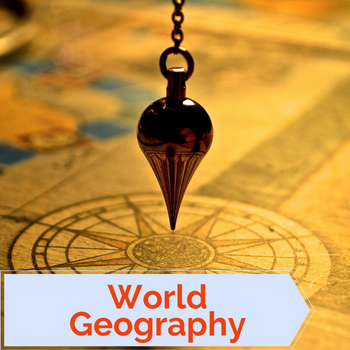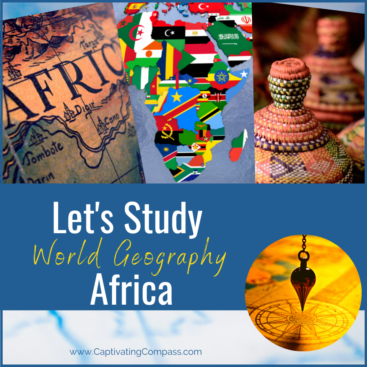Online World Geography in High School
A great way to broaden a teen’s worldview.
There are loads of reasons for online study of world geography in high school. Beyond it being fun, engaging, and a great way to broaden a homeschooler’s worldview, there are some very specific skills and values that are established when studying world geogrpahy. Let’s dive into a few of them.

Understanding Global Diversity
World geography in high school invites students to explore the diverse cultures and regions that shape our planet. By exploring continents like South America, Europe, and Africa, high school students gain a broader perspective of the world beyond their local environment. Understanding different countries and their customs fosters an appreciation for cultural geography, teaching students to respect and value human behavior across various societies. This global awareness is crucial in today’s interconnected world.
World Geography Courses
Incorporating world geography into the school year enriches the social studies curriculum and helps meet state requirements. It provides a comprehensive learning experience that goes beyond traditional Core 4 subjects. By studying specific regions such as the Middle East, South Asia, and Central America, students can grasp the complexity of human geography and the beauty of each unique culture. This knowledge helps them understand how cultural and economic factors influence societies. High school world geography courses, like Arise Home Education’s World Geography, allow students to explore current events within a geographical context, which enhances their critical thinking skills.

Exploring Physical and Human Geography
High school students studying world geography in a homeschool setting can examine both physical and human geography. The physical world offers a fascinating array of geographical features, from the vast plains of North America to the unique landscapes of Australia. Understanding these features can help students appreciate the diversity of the physical environment and how it affects human life. By analyzing natural elements, students can better comprehend how geography influences settlement patterns, agriculture, and industry.
Human geography focuses on how people interact with their environment. This aspect of world geography encourages students to study the impact of human activities on different regions. By investigating topics like urban development and resource management, students gain insight into the challenges facing specific areas. This knowledge is invaluable in shaping informed citizens who are aware of global issues. Students also learn about the significance of geographical features in the development of civilizations and how they shape human behavior.
Enhancing Critical Thinking and Student Progress
The study of geography in high school is not just about memorizing maps and capitals. It’s about developing critical thinking skills and understanding the physical and cultural landscape of the world. By engaging with world geography courses, students learn to analyze data and draw connections between geographical phenomena and societal trends. These skills are transferable to other subjects, contributing to overall student progress and academic confidence.
Daily lessons on world geography encourage high school students to think critically about their surroundings and the broader world. They learn to evaluate the impact of geographical factors on current events, enhancing their ability to engage with global news. As students progress in their understanding of geography, they become more informed, empathetic citizens. This prepares them for future challenges in an ever-changing world, making the study of geography an essential part of high school education.
Engagement with Different Cultures
Exploring Cultural Geography
Understanding cultural geography provides high school level students with insights into human behavior and interactions within various regions. This special emphasis in world geography courses allows students to delve deep into the cultural systems of different countries, from Southwest Asia or Australia to North Africa. Captivating Compass’s courses encourage students to explore how cultural practices influence societal norms in diverse regions like South America and Central Asia. By examining cultural geography, students are able to appreciate the rich tapestry of human expressions across the globe, enhancing their social studies experience.
High school world geography lessons often incorporate case studies from specific regions, such as the Middle East and Central America. These studies provide real-world contexts for students to analyze cultural differences and similarities. Online classes or dinner table discussions can expand on how these cultural traits shape economies, politics, and the environments of each region. This understanding fosters critical thinking and encourages students to reconsider preconceived notions about foreign cultures. By learning about different countries and their cultural practices, students gain a global perspective, essential for their future.
Interaction with Current Events
World geography high school unit studies and online courses often integrate current events into daily lessons to highlight the dynamic nature of cultural geography. High school students are given the opportunity to better understand recent developments in Europe, Africa, the United States of America, and beyond. This exposure helps teens understand how current events can affect cultural and human geography. By connecting geographical features with current events, students see the relevance of geography in understanding the physical world.
Students may want to examine how cultural shifts impact population trends and migration patterns across continents. For example, discussing the impact of political changes in the Middle East on global migration patterns helps students grasp the complexity of cultural interactions. Through such explorations, students enhance their critical thinking skills and deepen their understanding of the world around them. This interaction with real-time events ensures that they are not just passive recipients of information but active participants in the learning experience.
Encouraging Empathy and Understanding
Engaging with diverse cultures in world geography courses encourages empathy among high school students. They learn about the unique challenges and lifestyles of people across different geographical regions, from the bustling cities of South Asia to the rural heartlands of Central America. These insights foster a deeper understanding of the human aspects of physical geography.
By studying cultural narratives and traditions, students grow more aware of the global community’s interconnectedness. High school world geography courses prepare students to navigate a multicultural world with sensitivity and respect. As students progress through a course, they develop a keen sense of global citizenship, essential for their personal and academic growth.
Development of Critical Thinking Skills
The Role of Geography in Enhancing Critical Thinking
High school world geography courses nurture critical thinking skills among students. Understanding the complex interplay of the physical world with human behavior requires analytical thinking. As students explore places like South Korea, New Zealand, and sub-Saharan Africa, they assess how geographical features influence cultural and social dynamics. This process challenges students to think critically about human geography and the factors that shape societies in different countries.
Engaging with world geography expands students’ perspectives, encouraging them to consider how geographical factors affect everyday life. By analyzing specific regions of continents, high school students learn to appreciate the diversity of human experiences. This broader understanding fosters the ability to approach problems from multiple viewpoints, a key aspect of critical thinking. Moreover, comparing geographical features across the Americas, Europe, Africa, Asia, and Australia further enhances students’ analytical skills.
World Geography by Continent
Enhancing Spatial Awareness and Skills
Understanding the Physical World
Online world geography courses in high school play an important role in enhancing spatial awareness. Students learn about diverse geographical physical features, such as mountains, rivers, and deserts, which shape our physical world. By studying specific regions with map skills, students can visualize the layout and characteristics of each continent. Exploring historical maps gives insight into the reality of exploration and how difficult it was for those discovering Earth’s land and physical features firsthand.
High school students are introduced to physical geography through engaging learning experiences. They explore the natural landscapes of regions, get a basic introduction to world language and customs, and enjoy hands-on activities and virtual tours to help them use the world as their classroom. This exploration helps develop their ability to identify and understand the importance of the geographical features. By the end of the school year, students have improved their spatial skills, enabling them to analyze and interpret the world map with increased accuracy.
Building Cultural and Human Geography Skills
Besides physical geography, high school world geography online courses emphasize cultural and human geography. Students examine human behavior and interactions within different countries and regions, such as Latin America or North Korea. This study helps students understand the interplay between human activity and the geographical environment. They analyze how cultures and communities are influenced by their surroundings, leading to a better understanding of social studies.
Incorporating the study of geography from middle school to high school provides a continuous learning experience. Students examine the cultural geography of places like South Asia and the United States, gaining insights into cultural diversity and societal developments. These lessons support student progress by refining their analytical skills and enhancing their ability to have an informed perspective on current events.
The Value of a Comprehensive Curriculum
World geography in high school offers students a broad understanding of the physical and human aspects of the world. By introducing high school students to topics like the physical geography of South America and the cultural geography of Europe, these courses enrich their learning experience. Through daily lessons, students explore the diverse geographical features that shape life in different countries. This not only aids in their critical thinking but also prepares them to understand current events in various regions, from the Middle East to Africa.
Integrating world geography courses with social studies provides a holistic view of global human behavior. Students gain insights into the socio-economic and political aspects of different parts of the world, including Europe and Asia. This comprehensive approach ensures that high school world geography is not just about maps and landscapes but also about understanding the complex interactions that define our world.

Bridging the Gap Between Middle and High School
Transitioning from middle school to high school can be challenging. World geography serves as a bridge that connects past knowledge with future learning. Middle school students often learn about basic geographical concepts. High school courses expand on this foundation, diving deeper into the study of specific regions.
By building on the knowledge acquired in middle school, high school geography courses enhance student progress. They offer opportunities to explore the physical world in a new light. This allows students to discover the intricate relationship between geographical features and cultural developments. This progression helps students develop a nuanced understanding of the world, fostering a lifetime appreciation for geography.
Preparing for a Global Future
In today’s interconnected world, understanding geography is crucial for future success. High school students equipped with knowledge about different countries and their geographical features are better prepared to face global challenges. World geography courses cultivate an awareness of cultural differences and similarities. This is essential for thriving in a diverse environment.
As students learn about regions like Africa and the Middle East, they develop empathy and a broader perspective on global issues. This understanding is vital for participating effectively in discussions on international topics and for making informed decisions as young, global citizens. By the end of the school year, high school students emerge with a solid grasp of the physical and human geography of our world. They will be ready to engage with it thoughtfully and responsibly.
Online World Geogrpahy Curriculum Package for High School










